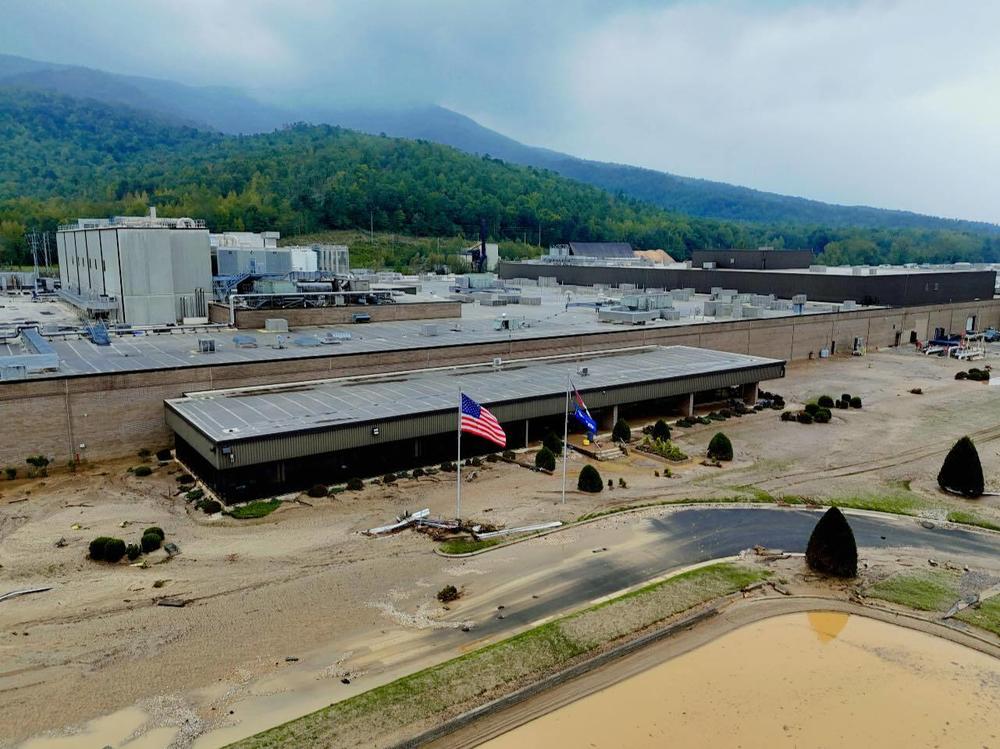Section Branding
Header Content
Nationwide IV fluid shortage changing how hospitals manage patient hydration
Primary Content
Hospitals around the country are conserving critical intravenous fluid bags to cope with a shortage that may last months. Some hospital administrators say they are changing how they think about IV fluid hydration altogether.
Hurricane Helene, which hit North Carolina in September, flooded a Baxter International facility that produces 60% of the IV fluids used in the U.S., according to the American Hospital Association.
The company was forced to stop production and is rationing its products. In an update posted Nov. 7, Baxter said its facility in Marion, N.C., has resumed producing some IV fluids.
On Monday, Health and Human Services Secretary Xavier Becerra toured the damaged factory.
He spoke to reporters near a temporary bridge that was rebuilt after the storm. It's now being used by trucks to transport IV products.
"When Baxter said, 'We need to figure out how to transport product, we don't have a functioning bridge anymore,' everyone stepped up. And while HHS isn't recognized for building bridges, we were able to help with FEMA in making that all possible," Becerra said.
In an email to KFF Health News, the company wrote that customers will be able to order normal quantities of "certain IV solutions products" by the end of the year, but there is no timeline for when the North Cove facility will be back to pre-hurricane production levels.
Meanwhile, hospitals are facing seasonal strains on their already limited IV fluid resources, said Sam Elgawly, chief of resource stewardship at Inova, a health system in the Washington, D.C., area.
"We've been very aggressive in our conservation measures," Elgawly said, stressing that he does not believe patient care has been compromised. He told KFF Health News that across the system IV fluid usage has dropped 55% since early October.
Elgawly called the shortage a crisis that he expects to have to continue managing for some time.
"We are going to operate under the assumption that this is going to be the way it is through the end of 2024 and have adopted our demand/conservation measures accordingly," he said.
At the end of the calendar year, many patients with insurance hurry to schedule surgical procedures before their deductibles reset in January.
Elgawly is eyeing that typical surgical rush and the impending peak of respiratory virus season as he tries to stockpile IV fluid bags.
Hospitals such as Inova's are using different ways to conserve, such as giving some medications intravenously but without a dedicated IV fluid bag, known as a push medication.
"You don't even need a bag at all. You just give the medication without the bag," he said.
"There has been increasing literature over the last 10 to 20 years that indicates maybe you don't need to use as much. And this accelerated our sort of innovation and testing of that idea."
Monica Coleman is a nurse at a Department of Veterans Affairs hospital in North Chicago. She said using push medications takes more time out of a nurse's already hectic schedule because then they need to monitor the patient.
"This could increase adverse effects within the patient, because we're giving the medication at a faster rate," she said.
Elgawly is also interested in retooling electronic health records to question doctor orders for more IV hydration.
"Does the patient actually need that second bag? How did they do today with eating or drinking water or juice? They did well? They don't need the bag. So it's little conservation mechanisms like that that, when you add them across, you know, the 2,000-patient system that Inova is, make a significant dent," he said.
Simpler conservation measures could become common after the shortage abates, said Vince Green, chief medical officer for Pipeline Health, a small hospital system in the Los Angeles area that mainly serves people on Medicare and Medicaid.
First, Green would like to see data showing that patient outcomes aren't affected. But for now, some of the new strategies just make sense to him. He has directed hospital staff to use up the entire IV bag before starting another.
"If they come in with IV fluids that the paramedics have started, let's continue it. If it saves half a bag of fluids, so be it, but it adds up over time," he said.
Patients may be asked to take more accountability for their hydration, by drinking Gatorade or water rather than the default of hydrating through an IV, he said.
"From an environmental aspect, we don't need to have this much waste and fill up our landfills. If we could reduce stuff, I think it'd be wise," he said.
But he'll feel better when his hospitals receive a full order, which could be weeks away. Green said they are down to a two-week supply, with an expected increase in hospitalizations due to respiratory virus season.
"We're purchasing every IV fluid bag that we can get," he said.
This story comes from NPR's health reporting partnership with KFF Health News, a national newsroom that produces in-depth journalism about health issues. KFF Health News is one of the core operating programs at KFF — the independent source for health policy research, polling, and journalism.

